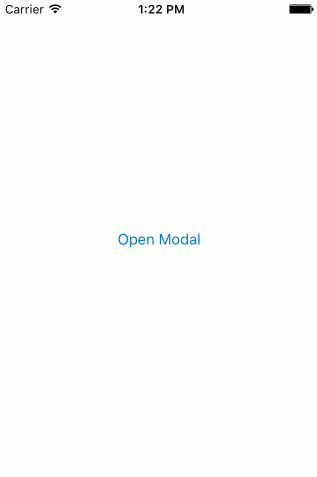In iOS, how to drag down to dismiss a modal?
I just created a tutorial for interactively dragging down a modal to dismiss it.
http://www.thorntech.com/2016/02/ios-tutorial-close-modal-dragging/
I found this topic to be confusing at first, so the tutorial builds this out step-by-step.

If you just want to run the code yourself, this is the repo:
https://github.com/ThornTechPublic/InteractiveModal
This is the approach I used:
View Controller
You override the dismiss animation with a custom one. If the user is dragging the modal, the interactor kicks in.
import UIKit
class ViewController: UIViewController {
let interactor = Interactor()
override func prepareForSegue(segue: UIStoryboardSegue, sender: AnyObject?) {
if let destinationViewController = segue.destinationViewController as? ModalViewController {
destinationViewController.transitioningDelegate = self
destinationViewController.interactor = interactor
}
}
}
extension ViewController: UIViewControllerTransitioningDelegate {
func animationController(forDismissed dismissed: UIViewController) -> UIViewControllerAnimatedTransitioning? {
DismissAnimator()
}
func interactionControllerForDismissal(animator: UIViewControllerAnimatedTransitioning) -> UIViewControllerInteractiveTransitioning? {
interactor.hasStarted ? interactor : .none
}
}
Dismiss Animator
You create a custom animator. This is a custom animation that you package inside a UIViewControllerAnimatedTransitioning protocol.
import UIKit
class DismissAnimator : NSObject {
let transitionDuration = 0.6
}
extension DismissAnimator : UIViewControllerAnimatedTransitioning {
func transitionDuration(transitionContext: UIViewControllerContextTransitioning?) -> NSTimeInterval {
transitionDuration
}
func animateTransition(transitionContext: UIViewControllerContextTransitioning) {
guard
let fromVC = transitionContext.viewControllerForKey(UITransitionContextFromViewControllerKey),
let toVC = transitionContext.viewControllerForKey(UITransitionContextToViewControllerKey),
let containerView = transitionContext.containerView()
else {
return
}
if transitionContext.transitionWasCancelled {
containerView.insertSubview(toVC.view, belowSubview: fromVC.view)
}
let screenBounds = UIScreen.mainScreen().bounds
let bottomLeftCorner = CGPoint(x: 0, y: screenBounds.height)
let finalFrame = CGRect(origin: bottomLeftCorner, size: screenBounds.size)
UIView.animateWithDuration(
transitionDuration(transitionContext),
animations: {
fromVC.view.frame = finalFrame
},
completion: { _ in
transitionContext.completeTransition(!transitionContext.transitionWasCancelled())
}
)
}
}
Interactor
You subclass UIPercentDrivenInteractiveTransition so that it can act as your state machine. Since the interactor object is accessed by both VCs, use it to keep track of the panning progress.
import UIKit
class Interactor: UIPercentDrivenInteractiveTransition {
var hasStarted = false
var shouldFinish = false
}
Modal View Controller
This maps the pan gesture state to interactor method calls. The translationInView() y value determines whether the user crossed a threshold. When the pan gesture is .Ended, the interactor either finishes or cancels.
import UIKit
class ModalViewController: UIViewController {
var interactor:Interactor? = nil
@IBAction func close(sender: UIButton) {
dismiss(animated: true)
}
@IBAction func handleGesture(sender: UIPanGestureRecognizer) {
let percentThreshold:CGFloat = 0.3
let translation = sender.translation(in: view)
let verticalMovement = translation.y / view.bounds.height
let downwardMovement = fmaxf(Float(verticalMovement), 0.0)
let downwardMovementPercent = fminf(downwardMovement, 1.0)
let progress = CGFloat(downwardMovementPercent)
guard interactor = interactor else { return }
switch sender.state {
case .began:
interactor.hasStarted = true
dismiss(animated: true)
case .changed:
interactor.shouldFinish = progress > percentThreshold
interactor.update(progress)
case .cancelled:
interactor.hasStarted = false
interactor.cancel()
case .ended:
interactor.hasStarted = false
interactor.shouldFinish ? interactor.finish() :
interactor.cancel()
default:
break
}
}
}
I'll share how I did it in Swift 3 :
Result

Implementation
class MainViewController: UIViewController {
@IBAction func click() {
performSegue(withIdentifier: "showModalOne", sender: nil)
}
}
class ModalOneViewController: ViewControllerPannable {
override func viewDidLoad() {
super.viewDidLoad()
view.backgroundColor = .yellow
}
@IBAction func click() {
performSegue(withIdentifier: "showModalTwo", sender: nil)
}
}
class ModalTwoViewController: ViewControllerPannable {
override func viewDidLoad() {
super.viewDidLoad()
view.backgroundColor = .green
}
}
Where the Modals View Controllers inherit from a class that I've built (ViewControllerPannable) to make them draggable and dismissible when reach certain velocity.
ViewControllerPannable class
class ViewControllerPannable: UIViewController {
var panGestureRecognizer: UIPanGestureRecognizer?
var originalPosition: CGPoint?
var currentPositionTouched: CGPoint?
override func viewDidLoad() {
super.viewDidLoad()
panGestureRecognizer = UIPanGestureRecognizer(target: self, action: #selector(panGestureAction(_:)))
view.addGestureRecognizer(panGestureRecognizer!)
}
@objc func panGestureAction(_ panGesture: UIPanGestureRecognizer) {
let translation = panGesture.translation(in: view)
if panGesture.state == .began {
originalPosition = view.center
currentPositionTouched = panGesture.location(in: view)
} else if panGesture.state == .changed {
view.frame.origin = CGPoint(
x: translation.x,
y: translation.y
)
} else if panGesture.state == .ended {
let velocity = panGesture.velocity(in: view)
if velocity.y >= 1500 {
UIView.animate(withDuration: 0.2
, animations: {
self.view.frame.origin = CGPoint(
x: self.view.frame.origin.x,
y: self.view.frame.size.height
)
}, completion: { (isCompleted) in
if isCompleted {
self.dismiss(animated: false, completion: nil)
}
})
} else {
UIView.animate(withDuration: 0.2, animations: {
self.view.center = self.originalPosition!
})
}
}
}
}